Introduction
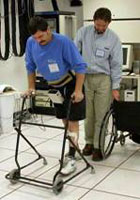
The line between weakness and paralysis is not absolute. A condition causing weakness may progress to paralysis. On the other hand, strength may be restored to a paralyzed limb. Nerve regeneration or regrowth is one way in which strength can return to a paralyzed muscle. Paralysis almost always causes a change in muscle tone. Paralyzed muscle may be flaccid, flabby, and without appreciable tone, or it may be spastic, tight, and with abnormally high tone that increases when the muscle is moved. The cause of paralysis may be any injury that tears or compresses the nerves; it may be hemorrhage, tumor, infection, or substances toxic to nerve tissue. One of the most frequent causes of paralysis is stroke, in which hemorrhage, thrombosis, or obstruction of a cerebral vessel interferes with nerve function.
Yoga and Paralysis
Yogic poses, called asanas, are key tools to obtaining benefits, ranging from the physical to spiritual. Evolving over the millennia, standing, sitting, bending, twisting, and reclining poses have been developed to enhance function in every body part. Various poses, especially in combination, are prescribed for diverse ailments, including those involving heart and circulation, respiratory, digestive, urinary, hormonal, immune, and brain and nervous systems. The word Yoga comes from Indian philosophy, it literally means union, and in this context refers to the union of the individual's soul with the universal. Yoga is an ancient philosophy of life as well as a system of exercises that encourages the union of mind, body, and spirit. In the words of Patanjali, author of the Yoga Sutras, "yoga is the ability to focus the mind on a single point without distraction." Yoga is a physical discipline; it uses the body and breathing to develop self-awareness and mental clarity.YOGA POSES FOR PARALYSIS
Mountain pose
The Mountain Yoga Pose promotes the experience of stillness, strength, relaxed power, and immovable stability associated with mountains. This yoga posture, and coming back to this stillness after other poses, is one of the ways of becoming acquainted with stillness.Child Pose
The Child Pose is a relaxation pose which is used to normalize the circulation after the Head Stand and to give a counter stretch to the spine after the backward bends. It is a resting pose that can be done to precede or follow any pose. Performing the Child Pose stretches the hips, thighs and ankles gently. It also helps relieve stress and fatigue, and calms the brainEasy Pose
This is one of the classic Meditative Poses and is usually performed after doing the Corpse Pose. The Easy Pose helps in straightening the spine, slowing down metabolism, promoting inner tranquility, and keeping your mind still. >Cat Pose
The Cat Yoga Pose teaches you to initiate movement from your center and to coordinate your movement and breath. These are two of the most important themes in Yoga practice. Keep in mind that the Cat Pose may not be advisable if you have any chronic or recent back pain or injury.Half Spinal Twist Pose
If done properly, the Half Spinal Twist lengthens and strengthens the spine. It is also beneficial for your liver, kidneys, as well as adrenal glands. Practice this Yoga Pose under the supervision of a Yoga instructor.YOGA ASANAS FOR PARALYSIS
VEERASANA
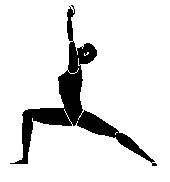
Steps
- Start with your hands and knees on the floor as in the Cat Pose. Have your knees hip-width apart so the thighs are parallel with one another, and separate your feet until they are slightly wider than your hips. Check that your feet are pointing directly backward, not turning in or out.
- Sit between your feet by first supporting yourself with your hands and then slowly lowering your hips to the floor. If you are unable to sit comfortably, or if you feel any pain in your knees, elevate your hips by placing a folded blanket. Eventually, you will be able to sit between your feet with no discomfort with your buttocks firmly on the ground.
- Sit tall. Counteract the tendency to slump by adjusting the buttock muscles sideways and back with your hands, and tilting the pelvis slightly forward so you are positioned on the frontal edge of each sitting bone. Then draw the abdomen backward toward the spine and delicately adjust your hips toward cat tilt to establish neutral alignment of your center, your pelvis making a ninety-degree angle with the thighs. You are now on the tips of the sitting bones.
- Rest your hands in your lap, on your thighs, or on your ankles, and then close your eyes. Elevate and free your chest, relax the shoulders back and down away from your ears, then lift or lower your chin until your head feels perfectly balanced, weightless on top of the spine. Sit quietly for at least a minute.
PARVATASANA
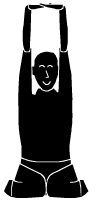
Steps
- Sit as in Padmasana.
- From the Padmasana posture slowly lifts the hips and thighs so that entire body weight lies on knee. Raise the hand up above the head.
- Stay in this posture for a few seconds and breathe evenly.
- Slowly bring the hands down and also rest the body on the ground and come back to a relaxed position.
- Stabilize the position and continue normal breathing.
SIDDHASANA
Siddh' is a Sanskrit word and its meaning is perfect one because one attains perfection in yoga by meditating in this pose. Siddhasana is the most recommended posture while meditation. The main function of this asana is to awaken the power of Kundalini the annular power residing in the mystical circle above the reproductive organs.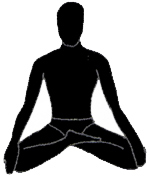
Steps
- Sit on the floor.
- Keep your legs stretch straight in front.
- Bend your left leg while holding the left heel.
- Place it near the perineum.
- Bend the right knee and put the right heel against the public bone.
- Place the back of the hands on the knees so that the palms face upward.
- Join the thumb and tip of index finger of each of the hand.
- While doing the whole activity keep your spine erect.
- Put your neck low so that the chin touches the lower part of throat.
MANDUKASANA

Steps
- Assume the Vajrasana posture with the posterior planted firmly on the floor between the upturned feet.
- The inner edges of the feet should encircle the posterior.
- Spread the knees as wide apart as possible and rest them on the floor.
- The feet should point towards each other with the soles facing upwards.
- Heels must point towards each other and the edges of the feet must touch the floor.
- The feet should be at right angles to the legs and the toes pointing outward.
- The big toes should touch each other behind the posterior.
- You will now be squatting between your heels
- Rest the hands, palms down, on the respective knees.
- Straighten the spine and look straight ahead.
- Sit erect in this position for about ten seconds without strain
ARDHAMATSYENDRASANA
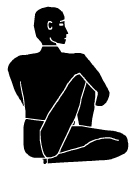
Steps
- Sit in Dandasana or the staff pose. With your legs straight out in front of you and place a blanket beneath your buttocks supporting them.
- Bending your knees, put your feet on the floor, and then slides your left foot under your right leg to the outside of your right hip. Place the outside of the left leg on the floor. Step the right foot over the left leg and stand it on the floor outside your left hip. The right knee must be pointing directly up at the ceiling.
- Breathe out or exhale twisting toward the inside of your right thigh. Press the right hand against the floor just behind your right buttock, and set your left upper arm on the outside of your right thigh near the knee. Pull the front of your torso and inner right thigh together. Place and pressing the inner right foot very actively into the floor, release the right groin, and lengthen front of the torso.
- Now leaning the upper torso back slightly, against the shoulder blades, continue to lengthen the tailbone into the floor.
- You can turn your head in one of two directions.
- Remain in this posture for about 30 seconds to 1 minute, then releasing out with a deep exhalation, return to the starting position, and repeat to the left for the same duration of time.
- As you go on to inhale lift your sternum pushing the fingers into the floor. Be sure that the twist is evenly distributed in the entire length of the spinal column
Diseases Related to Sagitarius |
||


